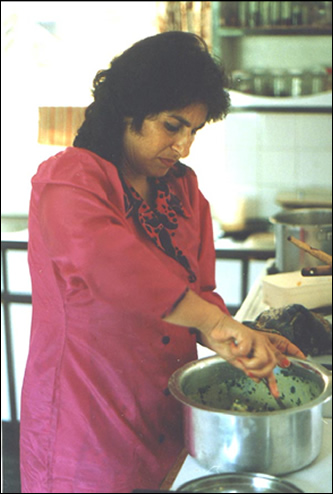Recipes

Featured Chef: FATHER ALDO
It’s nearly dark in Samburu District, Kenya. A development worker with a Ph.D in zoology from Cambridge – Dr. Chris Fields – and I have been driving all day on a ten day working safari, from desert to desert, through brown scrub desert, white sand desert, pale-lavender and ice-green desert, and trackless yellow desert. Piles of rock, mountain high, shade us for a stretch, the red dirt tracks us through a pass, then we slide more than drive down 100 feet on a narrow river of loose rock. The sun beats down as a barefoot Samburu boy races down the rocks after us, clutching a new born white goat under his arm. Not many pass this way.
A consummate researcher, Chris has spent his best years in the desert country introducing the versatile, eco-friendly camel to the Samburu herdsmen. Today, just as the sun is sinking, Chris has found what he has been looking for. We leave the desert floor and drive up to a small, flat, isolated, and lonely hilltop. The only landmark, hardly discernible on the top of the hill in the gathering darkness is a small chapel’s steeple. In an otherwise empty landscape, the small cross on the steeple means a safe place to stay and a hot meal. As we drive up, Father Aldo Vettori bustles out to greet us, grinning broadly and coaxes us into his small house. Without a phone, he has had no idea of our impending arrival yet he happily leads us into the only finished room in the house — the kitchen. Here, a new wooden table is overflowing with food. He prompts us to sit down to a full-blown meal of rich pasta soup, cold meats, cheeses, and bread with plenty of fresh mangoes, bananas and pineapples. Chris knows all the Catholic missions out here in this trackless desert from Marasabit through Maralal to the forested village of Gatab high atop Mount Kulal which rises out of the desert at the southeastern tip of Lake Turkana and tracks his journeys here among the Samburu with compass-worthy intuition.
The next day, Father Aldo takes us out into the desert to check on his responsibilities which is the building of a small reservoir. Then at noon, we head back to his house for a lunch of goat liver and fruit salad. I cannot bear liver, but Father Aldo lovingly created a miracle. Goal liver is the most astonishingly good dish.
Before we started on Father Aldo’s morning’s travels, he left a portion of thoroughly cleaned, thinly sliced liver out on a clean chopping board for when we returned. Now, with a twinkle in his eye, he cheerfully warms a bit of olive oil in a steep-sided pan, heaps sliced white onion rings into the same pan, and adds the meticulously cleaned liver. Then he gently stirs the pot with care until the liver is done. A lovely rich gravy of the oil and pan drippings collect in the bottom of the pan. He serves the liver with the natural sauce and passes a salad of freshly shredded cabbage, carrots and sliced tomatoes which are grown all over Kenya in the carefully tended, small gardens of the local people.
For dessert he serves us one of his own concoctions of fresh fruit and avocados followed with more cheese, bread and espresso coffee. This simple fare was way ahead of its time…..everything natural, grown and made locally with the exception of the coffee which is grown in abundance in Kenya but which he would have brought into the mission perhaps from the savanna town of Nanyuki (our safari starting point).
Father Aldo’s lunch of goat liver, salad and fruit dessert serves 4.
Sweet Fruit Salad with Avocados
- 1 cup water
- 4 tablespoons sugar
- 1/2 fresh pineapple, cubed
- 2 large bananas, sliced
- 1 firm ripe avocado, cubed.
In a saucepan combine the water and sugar and bring to a boil. When the syrup is slightly thickened, set aside and cool. Add the fruit and avocado and refrigerate in a covered bowl or serve immediately.
As a aside, at one of the missions along the way we traveled not far from Father Aldo as the crow flies, the Fathers grow avocados in the desert with careful water management. I found avocados in hot dry climates all over Kenya. I am assuming that the well-drained soil — to say the least — was one of the factors of success.
–from KARIBU: WELCOME TO THE COOKING OF KENYA, by Ann Gardner
Recipes

Featured Chef: Razia Khan
Razia Khan was raised in Moi’s Bridge between Eldoret and Kitale in the lush highlands of the Uasin Gishu plateau, Kenya, where her father, originally from Pakistan, ran a shop. Her cooking is characterized by simple preparation and complex flavors. In Pakistani tradition, she uses herbs extensively. Her cupboard includes black, white and green cardamom, whole dried chiles, caraway seed, nutmeg, mustard seed, rye seed, black cumin, sesame seed, fenugreek, paprika, thyme, sage, aniseed, garam masala, coriander seeds and ground coriander, all kinds of grains and nuts, and homemade chutneys, In her fridge she keeps frozen garlic, cilantro, mint….and the list goes on and on. For tummy upsets, she boils mint and aniseed for a tea or broth. Or combines a mixture of dried aniseed, cardamom and sesame seed in equal amounts after dinner. Another simple remedy is to chew well a teaspoon of cumin seed. This not only helps indigestion but also acts as a natural breath “mint.”
Chicken with Spinach and Yogurt
- 1 cup plain yogurt
- 2 cups finely chopped spinach (well rinsed and drained)
- 1 cup finely chopped fresh cilantro
- 1/2 cup finely chopped fresh mint
- 1 2-pound chicken cut into pieces
- 1/2 cup vegetable oil 1 medium onion, grated
- 2 medium tomatoes finely chopped 1 tsp crushed fresh garlic 1 tsp crushed fresh ginger
- 1 tsp ground red (cayenne) pepper
- 1 tsp ground cumin 1 tsp ground turmeric
- 1 tsp salt
Combine the yogurt, spinach, cilantro, and mint. Coat the chicken well with the mixture and allow to marinate 1 hour. Heat the oil, add the onion, and when brown, add the tomatoes, garlic, ginger, all the spices and salt. Then add the chicken along with the green marinade. Cook slowly and simmer stirring frequently until you can see oil and the chicken is tender. Serve with rice and a green salad. Serves 4 to 6.
–from KARIBU: WELCOME TO THE COOKING OF KENYA, by Ann Gardner

